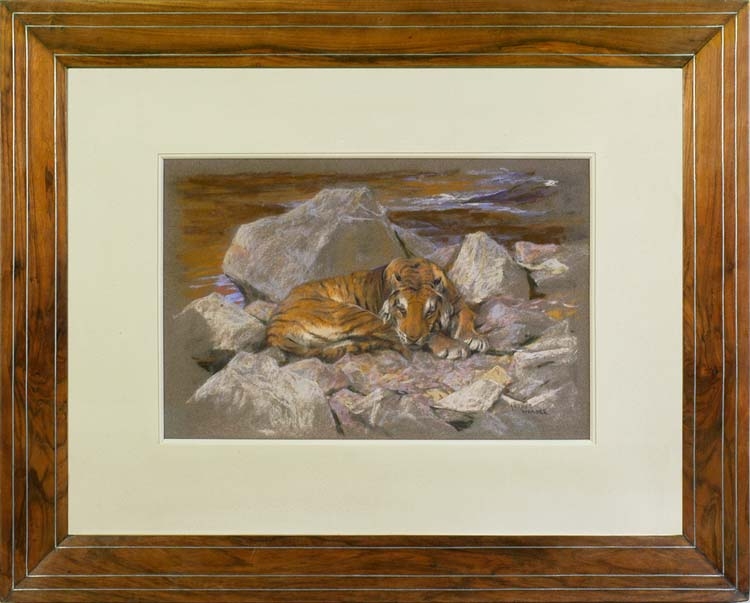This pastel study of a tiger on tinted paper is a quintessentially Wardlesque work. The setting may well be the rocks of Exmoor, which he knew from his holidays there, whilst the tiger will have been painted in London Zoo; however, the combination is far greater than the sum of its parts, having the authenticity of intimate knowledge and observation. Wardle was popular with public and critics alike for his ability to catch the poses, movements and expressions of every animal he portrayed, and here he seems to have captured a distillation of tigerness. Texture, colouring, light & shade, are all caught spontaneously and accurately, but each becomes the servant of Wardle’s empathy with his subject, and his capacity to infuse it with the sense of danger inherent in this wild and savage animal.
Biographical details
Arthur Wardle was apparently self-taught: that is, he did not attend art school, but may have taken lessons from members of the artists’ enclave in Chelsea, where he grew up. He was born in 1864, and exhibited his first painting in the Royal Academy in 1880, at the age of only sixteen. During his subsequent 55-year career, over a hundred of his works were accepted by the Academy; he also exhibited with the Society of British Artists, and in 1931 had a solo show at the Fine Art Society. He became a member of the Pastel Society in 1911, and of the RI in 1922, having equal facility in various media – oils, watercolours and pastels.
He was similarly versatile with his subjects, which (although they were mainly animals) included almost every species, both exotic and domestic (his precocious RA entry was a picture of cattle grazing). For the first ten years of his career, however, he produced mainly landscapes; it was in c.1890 that his extraordinary ability to depict any animal which moved became apparent, and from that point until he ceased to exhibit in 1935 he concentrated on animal-painting – particularly big cats and domestic dogs. His submissions to the Academy cleverly included not only these straightforward studies of creatures within landscape settings, hunting, playing or resting, but also mythological subjects which combined animals with the classical gods, thus investing his subjects with the respectability of history painting. Examples include The flute of Pan (Christie’s, 1996) and The enchantress (Christie’s, 1997).
Wardle lived in St John’s Wood so that he was close to London Zoo, where most of his initial studies were made. With these, his collection of animal skeletons and models, and his landscape sketches of Devon, he was able to create extraordinarily naturalistic and dramatic evocations of tigers, leopards and other cats in their native habitats. He was supposed by his family never to have ventured abroad at all, but it is likely that he did visit Africa and – late in his painting life – India.
Pastel painting acquired a new lease of life from the 1890s, and Wardle was profoundly taken with the medium. Pastels made it possible for him to produce rapid studies of creatures in constant motion, and to do so in pure colours on tinted paper; some of his best work is in this medium.
He became very popular with the public for his oil paintings of dogs, particularly terriers; he worked for dog breeders, immortalizing their champions, and was also commissioned to produce designs for Players’ cigarette cards. He had other commercial work – book illustration, postcards and chocolate box lids; whilst his WWI recruitment poster, ‘The Empire needs Men!’, has achieved sufficient fame to illustrate his biography on Wikipaedia.
Works in public collections include A tiger fighting a crocodile and Tigers at kill (both in the unfortunately defunct Dahesh Museum of Art, New York); Portrait of a deerhound, 1896 (British Sporting Art Trust Collection, Newmarket); Deer stalkers (Leeds Museums & Galleries); Study of a pointer (Chelmsford Museums); and three works in the National Museum of Wildlife Art, Wyoming.
See ‘Animal Painter: Arthur Wardle’, John Payne, at http://www.johnpayne.portraitcorner.co.uk/animal-painter-arthur-wardle.htm .


